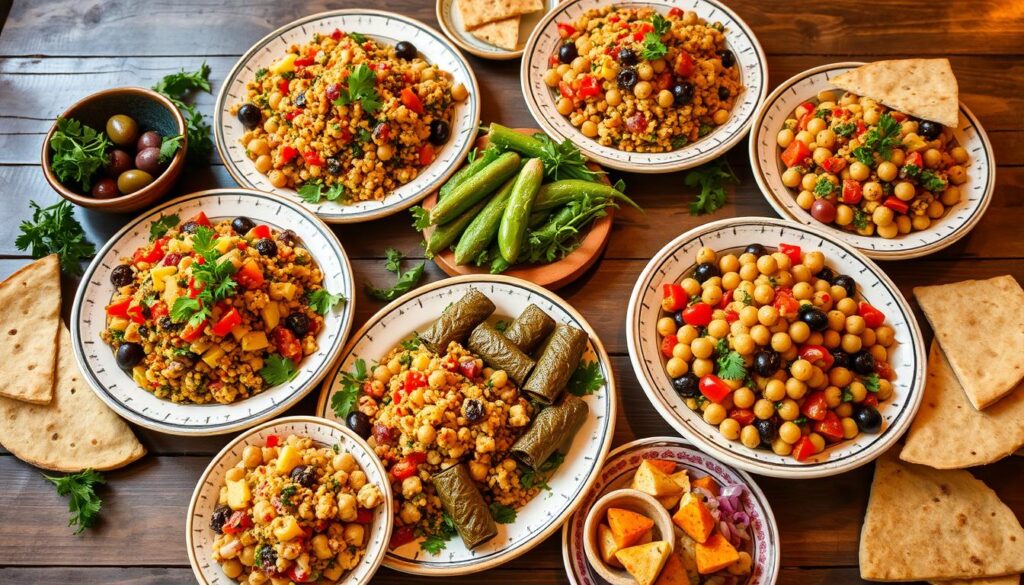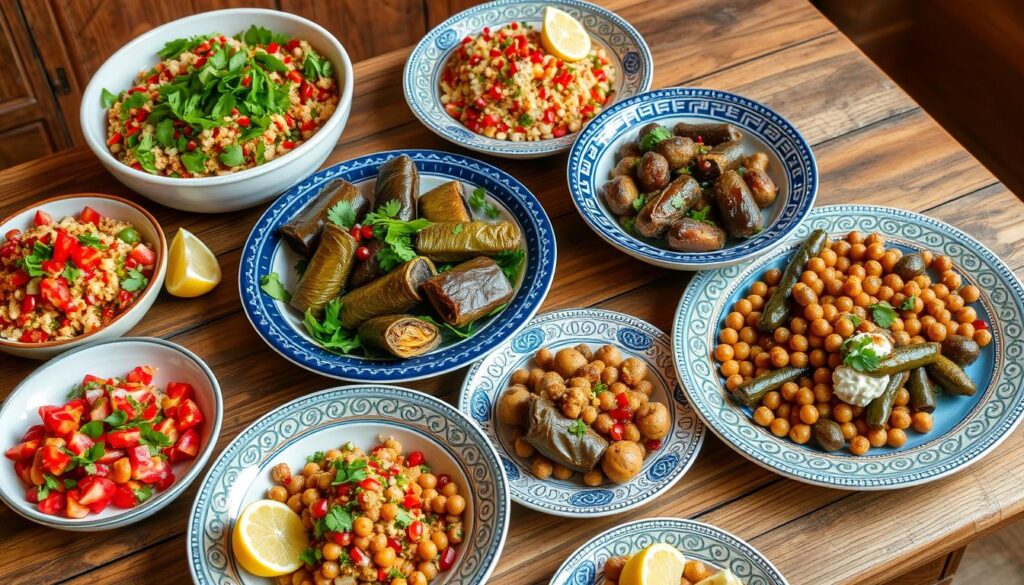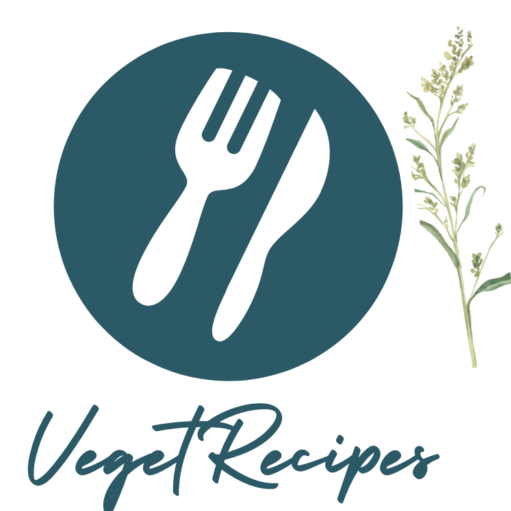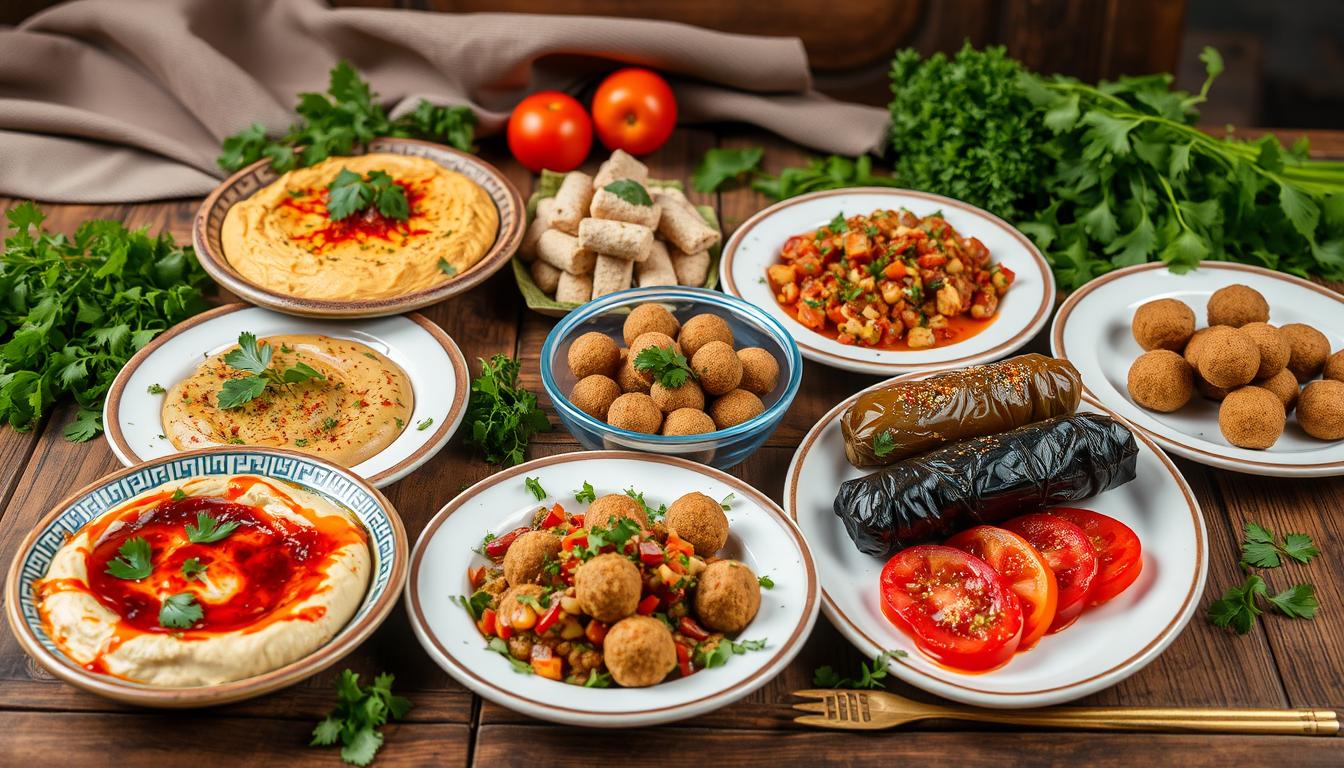Did you know the average person only spends 32 minutes on dinner prep on weeknights? A study by the U.S. Department of Agriculture found this. With our busy lives, finding quick and healthy meals is a must.
Middle Eastern cuisine is known for its bold flavors and health benefits. It offers many vegetarian dishes perfect for weeknights. Imagine making a delicious meal that’s good for you, all in a short time. Whether you’re new to vegetarian Arabic food or love it, these recipes will amaze you.
These recipes use spices like za’atar, legumes, and grains. They’re easy to make and full of flavor. As we explore these dishes, you’ll see how Middle Eastern cuisine can make your weeknights special. You’ll enjoy healthy meals without spending hours cooking.
Key Takeaways
- Enjoy quick and easy Middle Eastern vegetarian recipes that save time on busy weeknights.
- Healthy Middle Eastern recipes offer rich, vibrant flavors without compromising nutrition.
- Essential ingredients include unique spice blends, legumes, grains, and fresh vegetables.
- Middle Eastern vegetarian dishes support both personal health and environmental sustainability.
- Discover the economic advantages of incorporating affordable Middle Eastern staples into your diet.
Introduction to Middle Eastern Vegetarian Recipes
Exploring Middle Eastern vegetarian recipes opens a world of vibrant flavors. This journey shows the authenticity and depth of plant-based Middle Eastern cuisine. Each dish offers a flavorful experience and a peek into rich traditions and cultural heritage.
The Richness of Flavors
Middle Eastern vegetarian dishes are unique because of their spices. Spices like cumin, turmeric, and za’atar create a harmonious blend. This blend is found in dishes like mujadara and fresh tabouli salad, leaving a lasting impression.
Both subtle and bold spices add to the extraordinary richness of plant-based Middle Eastern cuisine.
Popular Ingredients in Middle Eastern Vegetarian Recipes
Key ingredients are essential in vegetarian Middle Eastern dishes. These include:
- Legumes: Lentils and chickpeas are central, providing protein and texture. Dishes like hummus and falafel show their versatility.
- Grains: Rice, bulgur, and couscous are staples, forming the base for hearty meals. Spiced dishes like pilaf and spiced bulgur wheat are favorites.
- Fresh Vegetables and Fruits: Zucchini, tomatoes, eggplants, and peppers add vibrant colors and fresh flavors. They’re used in dishes like fattoush salad and baba ganoush.
- Spices and Herbs: Middle Eastern cuisine is known for its spices. Spices like sumac, pepper, and sesame seeds enhance the taste and aroma of every dish.
| Ingredient | Common Uses | Benefits |
|---|---|---|
| Chickpeas | Hummus, Falafel | High in Protein |
| Lentils | Mujadara, Lentil Soup | Rich in Fiber |
| Bulgur | Tabouli Salad | Low in Calories |
| Spices (e.g., Cumin, Turmeric, Za’atar) | Various Dishes | Anti-inflammatory |
| Fresh Vegetables | Variety of Salads | Rich in Vitamins |
Benefits of Middle Eastern Vegetarian Recipes
Trying Middle Eastern vegetarian recipes is a treat for your taste buds. It also brings many benefits. These include health perks, good for the planet, and saving money.
Health Benefits
Healthy Middle Eastern recipes are great for your health. They are similar to the Mediterranean diet, known for heart health. A 2019 study found these diets can prevent and manage chronic diseases.
These recipes include whole grains, fruits, and veggies. They help lower heart disease risk and slow aging. Legumes, nuts, and olive oil add proteins, fats, and antioxidants. This improves blood vessels and cholesterol.
A big study followed 25,000 women for 25 years. It showed a Mediterranean diet lowers mortality by one-fifth compared to industrial diets.
Environmental Impact
Choosing healthy Middle Eastern recipes is good for the planet. They reduce carbon footprint and save water compared to meat diets. These diets focus on plants, which is better for the environment.
Vegetarian diets help biodiversity and ecosystems. Middle Eastern recipes are climate-friendly. They support a sustainable and healthy planet.
Economic Advantages
Healthy Middle Eastern recipes are budget-friendly. Ingredients like grains, legumes, and veggies are cheaper than meat. This helps manage food budgets while eating well.
Cooking at home with local ingredients saves money. It avoids dining out and processed foods. This fits well with the Mediterranean diet’s focus on freshness and simplicity.
The table below shows nutrient-rich ingredients in Middle Eastern vegetarian recipes:
| Ingredient | Nutrient Benefits |
|---|---|
| Chickpeas | High in protein, fiber; helps control blood sugar and lower cholesterol. |
| Olive Oil | Rich in antioxidants; may reduce inflammation and lower the risk of heart disease. |
| Garlic | Contains sulfur compounds; may reduce the risk of heart disease and cancer. |
| Tomatoes | Packed with antioxidants; may reduce the risk of various cancers. |
| Parsley | Supports immune system, eye, bone, and heart health. |
| Sesame Seeds | Provide healthy fats; beneficial for bones and brain health. |
Essential Ingredients for Middle Eastern Vegetarian Recipes
Middle Eastern vegetarian cooking is all about fresh, vibrant ingredients. These dishes mix textures, colors, and flavors. They celebrate the region’s rich culinary heritage.
Spices and Herbs
Talking about vegetarian Lebanese recipes means talking about spices. Saffron, mint, and parsley are key, adding unique flavors and health benefits. Ras el hanout, a spice blend, makes dishes like mujadara and soups taste amazing.
Legumes and Grains
Legumes and grains are the heart of many Middle Eastern vegetarian dishes. Mujadara, for example, combines lentils, rice, and caramelized onions. It’s a protein-rich meal, spiced with ras el hanout, allspice, and salt.
The dish uses simple ingredients like white basmati rice and yellow onions. But the spices add a complex flavor. This makes it both nutritious and satisfying.
Fresh Vegetables and Fruits
Fresh veggies and fruits are key in vegetarian Lebanese recipes. They bring texture, color, and nutrients. A vegetable tray bake, for instance, includes cauliflower, butternut squash, and red bell pepper.
Adding canned chickpeas and spices like cumin and smoked paprika makes it hearty. For the best flavor, toast and grind whole spices before using.
Quick and Easy Middle Eastern Vegetarian Recipes

Explore the Middle East’s flavors with these easy vegetarian middle eastern meals. They’re great for busy weeknights. Each dish is full of nutrients, making them tasty and healthy. You’ll find hummus, baba ganoush, and stuffed grape leaves to please your taste buds. These quick middle eastern dishes are easy to make, saving you time without losing flavor.
Hummus Variations
Hummus is a Middle Eastern favorite and a hit worldwide. It’s easy to make and can be changed to fit your taste. Start with chickpeas, tahini, lemon juice, and garlic. Then, add roasted red peppers for a smoky taste or beets for a pink color and earthy flavor. You can try many variations, all perfect for a quick middle eastern dish.
| Hummus Variation | Main Ingredient | Flavor Profile |
|---|---|---|
| Classic Hummus | Chickpeas | Rich and Tangy |
| Roasted Red Pepper Hummus | Red Peppers | Smoky and Sweet |
| Beet Hummus | Beets | Earthy and Vibrant |
Baba Ganoush
Baba ganoush is a smoky, creamy eggplant dip loved for its unique taste. Roast or grill eggplants until charred. Then, blend with tahini, olive oil, lemon juice, and garlic. This quick middle eastern dish is great with pita bread or veggies.
Stuffed Grape Leaves
Stuffed grape leaves, or dolma, are a tasty and healthy choice. Fill grape leaves with rice, pine nuts, herbs, and spices. Cook them in lemony broth until tender. This dish is perfect as a main or side, making it a great option for any meal. It’s a must-try for its rich flavors and ease of making.
Hearty Middle Eastern Vegetarian Recipes

Exploring hearty vegetarian meals from the Middle East reveals a trove of comforting and substantial dishes. These meatless Middle Eastern meals are not only rich in taste but are also nutrient-dense. They make perfect filling, satisfying suppers. Here are three standout recipes: Vegetarian Moussaka, Lentil Soup with Spices, and Stuffed Bell Peppers.
Vegetarian Moussaka
Vegetarian Moussaka is a delightful dish made of layers of roasted eggplant, zucchini, and potatoes. It’s topped with a creamy béchamel sauce. The robust flavor, flavored with cinnamon and nutmeg, shows its culinary heritage.
Lentil Soup with Spices
Lentil Soup with Spices is a quintessential hearty vegetarian meal. It combines red lentils with traditional spices like cumin, coriander, and turmeric. This soup warms the soul and provides a substantial protein boost without meat.
Stuffed Bell Peppers
The Stuffed Bell Peppers recipe fills bell peppers with a savory mixture of rice, tomatoes, and Middle Eastern spices. It’s a great example of meatless Middle Eastern meals that deliver flavor and nutrition. It’s perfect for a satisfying dinner.
- Vegetarian Moussaka Ingredients:
- 1 large eggplant, sliced
- 2 zucchini, sliced
- 3 potatoes, peeled and sliced
- 1/4 cup olive oil
- 1 onion, chopped
- 3 cloves garlic, minced
- 1 can crushed tomatoes
- 1/2 tsp cinnamon
- 1/4 tsp nutmeg
- Salt and pepper to taste
- Lentil Soup with Spices Ingredients:
- 1 cup red lentils
- 1 onion, chopped
- 2 cloves garlic, minced
- 1 carrot, diced
- 1 tbsp olive oil
- 1 tsp ground cumin
- 1 tsp ground coriander
- 1/2 tsp ground turmeric
- Salt and pepper to taste
- 6 cups vegetable broth
- Stuffed Bell Peppers Ingredients:
- 4 bell peppers, tops cut off and seeded
- 1 cup cooked rice
- 1 can diced tomatoes
- 1 onion, chopped
- 3 cloves garlic, minced
- 1 tbsp olive oil
- 1 tsp ground cumin
- 1/2 tsp paprika
- Salt and pepper to taste
| Dish | Main Ingredients | Key Spices | Cooking Time |
|---|---|---|---|
| Vegetarian Moussaka | Eggplant, Zucchini, Potatoes | Cinnamon, Nutmeg | 1.5 hours |
| Lentil Soup with Spices | Red Lentils, Carrot, Garlic | Cumin, Coriander, Turmeric | 45 minutes |
| Stuffed Bell Peppers | Bell Peppers, Rice, Tomato | Cumin, Paprika | 1 hour |
Light and Refreshing Middle Eastern Vegetarian Recipes
Middle Eastern cuisine is perfect for warm days with its light and refreshing dishes. These salads are not only healthy but also full of flavor. From Fattoush to Tabouli, there’s something for everyone. Adding a roasted vegetable salad makes for a complete, yet light meal.
Fattoush Salad
Fattoush is a must-try for light vegetarian dishes. It mixes fresh greens, tomatoes, cucumbers, and radishes with toasted pita bread. A citrusy dressing with sumac and lemon juice adds a zesty kick. The crunchy veggies and tangy dressing make it a flavorful delight.
Tabouli Salad
Tabouli is a simple yet flavorful salad. It’s made with chopped parsley, mint, tomatoes, and bulgur wheat, all dressed with lemon juice and olive oil. Its bright green color and refreshing taste make it a favorite.
Roasted Vegetable Salad
A roasted vegetable salad adds variety to your vegetarian dishes. It uses seasonal veggies like red bell peppers, zucchini, and eggplant. Roasting brings out their sweetness, and a light vinaigrette makes it a satisfying salad.
These salads highlight the diversity and health focus of Middle Eastern cuisine. They’re made with fresh ingredients and bold flavors. Enjoying Fattoush, Tabouli, or a roasted vegetable salad will add excitement to your meals.
Flavorful Middle Eastern Rice and Grain Dishes
Middle Eastern grain dishes like spiced bulgur wheat and pilaf with nuts and dried fruits are key in the region’s vegetarian food. These dishes are a big part of the local culture. They offer a mix of flavors that show the heart of Middle Eastern cooking.
Spiced Bulgur Wheat
Spiced bulgur wheat is a big deal in Middle Eastern grain dishes. This healthy grain gets a boost from spices, making it tasty and fragrant. Onions, garlic, and bay leaves add to its flavor, along with cumin and sea salt.
Sautéed in olive oil until soft, it’s a great choice for a vegetarian meal.
Pilaf with Nuts and Dried Fruits
Pilaf is a star in Middle Eastern grain dishes, thanks to nuts and dried fruits. The mix of crunchy nuts and sweet dried fruits is amazing. This vegetarian rice dish is a treat for your taste buds and looks great on the table.
It’s made with white basmati rice, olive oil, and fresh herbs like dill or parsley.
Here’s what you need:
- 2 cups of white basmati rice
- ½ cup of dried rice vermicelli noodles
- 2 tablespoons of extra virgin olive oil
- ½ teaspoon of salt
For a richer taste, try brown basmati rice instead. You’ll need 4 cups of water and cook for 22-25 minutes. It’s quick to make, under 30 minutes, and packed with nutrients. Enjoy it warm, topped with black pepper and fresh herbs.
Here’s a quick look at the nutritional content per serving:
| Nutrient | Amount per Serving |
|---|---|
| Calories | 251 kcal |
| Carbohydrates | 48g |
| Protein | 3g |
| Fat | 3g |
| Sodium | 173 mg |
| Potassium | 53 mg |
These vegetarian rice recipes are delicious on their own. They also go great with other Middle Eastern vegetarian dishes. They add rich flavors and nutrients to your meals. Whether it’s for a weeknight dinner or a special occasion, these dishes will make your meal unforgettable.
Delectable Middle Eastern Vegetarian Recipes
Exploring vegan Middle Eastern cooking reveals a world of tasty and healthy snacks. These delicious vegetarian snacks are full of flavor and support a healthy lifestyle. Let’s look at two snacks that are simple to make and very enjoyable.
Zaatar Pita Chips
Zaatar Pita Chips are loved in Middle Eastern cuisine and are a key part of vegan Middle Eastern cooking. They are tasty delicious vegetarian snacks that are easy to make at home. You just need pita bread, olive oil, and zaatar.
- Preheat your oven to 375°F (190°C).
- Cut the pita bread into triangles and brush with olive oil.
- Sprinkle the pieces with a mix of zaatar, sumac, and sesame seeds.
- Bake for about 10 minutes until they turn golden brown and crispy.
These chips are great for dipping in hummus or eating on their own. Their flavors make them a must-have snack.
Roasted Chickpeas
Roasted Chickpeas are another great choice for a healthy snack. They are full of protein and fiber, making them a favorite in vegan Middle Eastern cooking. Here’s how to make them:
- Preheat your oven to 400°F (200°C).
- Drain and rinse a can of chickpeas, then pat them dry with a paper towel.
- Toss the chickpeas with olive oil and your favorite spices (try cumin, paprika, and a pinch of salt).
- Spread them out on a baking sheet and roast for 30-40 minutes until they’re golden and crispy.
You can enjoy these Roasted Chickpeas as a snack or add them to salads for extra crunch. They’re a versatile snack that brings Middle Eastern flavors to your table.
| Ingredient | Quantity | Preparation Time | Cooking Time |
|---|---|---|---|
| Zaatar Pita Chips | Pita bread, olive oil, zaatar, sumac, sesame seeds | 10 minutes | 10 minutes |
| Roasted Chickpeas | Chickpeas, olive oil, cumin, paprika, salt | 5 minutes | 30-40 minutes |
These recipes are not just tasty but also fit into any busy schedule. They’re perfect for weeknight snacks or party appetizers. Dive into the world of vegan Middle Eastern cooking with these quick and delicious vegetarian snacks that everyone will love.
Traditional Middle Eastern Vegetarian Recipes
Traditional Middle Eastern desserts are a sweet treat after any meal. Two favorites are Baklava with Nuts and Rosewater Rice Pudding. They are known for their rich flavors and authentic taste.
Baklava with Nuts
Baklava is a classic dessert from the Middle East. It has layers of phyllo pastry, nuts, and a sweet syrup. The syrup is made with honey and rosewater.
Making Baklava takes some practice, but it’s worth it. It includes walnuts, pistachios, or almonds, mixed with sugar and spices. The layers are topped with a syrup made from sugar, water, and rosewater.
Rosewater Rice Pudding
Rosewater Rice Pudding is a beautiful dessert from Middle Eastern cuisine. It’s made with rice, milk, and rosewater. It’s often topped with cinnamon or chopped nuts.
This dessert combines the floral taste of rosewater with creamy rice pudding. It’s a light and comforting treat. It’s a great way to end a Middle Eastern meal.
Meal Prep Tips for Middle Eastern Vegetarian Recipes
Effective meal prep can make a big difference in adding tasty Middle Eastern vegetarian meals to your diet. These tips help you prep meals better and store vegetarian food well. This keeps it fresh and flavorful.
Planning Your Week
Planning your week can make meal prep for vegetarian meals easier. With five dinner recipes for four adults each week, each recipe is quick and budget-friendly. They use nutritious Mediterranean ingredients to help you meet your dietary goals.
- Pick recipes that use fewer ingredients to save money and avoid late-night food delivery.
- 83.6% of the recipes are vegan, fitting the trend towards plant-based diets and providing variety.
- Half of the recipes use traditional ingredients like tahini, bulgur wheat, and za’atar for an authentic taste.
- Set aside time for Mediterranean-inspired recipes, with an average cooking time of 30 minutes for weeknight dinners.
Here’s a sample meal plan for efficient planning:
| Day | Recipe | Prep Time | Middle Eastern Region |
|---|---|---|---|
| Monday | Vegetarian Maqloobeh | 90-120 minutes | Syria |
| Tuesday | Spiced Bulgur Wheat | 30 minutes | Lebanon |
| Wednesday | Lentil Soup with Spices | 30 minutes | Palestine |
| Thursday | Stuffed Bell Peppers | 35-40 minutes | Middle Eastern |
| Friday | Tabouli Salad | 30 minutes | General Middle Eastern |
Storing Leftovers
Storing vegetarian food properly keeps leftovers fresh and tasty. Use portioned containers for individual servings. This helps keep each dish’s flavor and quality.
- Airtight containers are key for keeping meal prep vegetarian meals’ flavors.
- Label each container with the dish’s name and prep date to track freshness.
- Store ready-to-eat dishes on the top shelf of your fridge and ingredients on the bottom.
- Freeze soups and stews to keep them longer and have a meal ready anytime.
With these tips, adding Middle Eastern vegetarian recipes to your weekly meals is easy. You’ll enjoy delicious and healthy meals with little effort.
Conclusion: Enjoying Middle Eastern Vegetarian Recipes
Exploring Middle Eastern vegetarian recipes is more than just cooking. It’s a journey that makes your taste buds happy and your body healthy. The Middle Eastern diet is all about fresh, healthy foods that boost your well-being. These recipes show that you can enjoy tasty vegetarian meals without losing flavor.
Try the protein-rich Falafel with warm pita and tangy tahini sauce. Or, enjoy the Vegetable Tagine and Mujadara for a heartwarming meal. Middle Eastern dishes offer a variety of flavors and textures, making every meal special.
These vegetarian recipes also help the planet. From the Fattoush Salad to Lentil Soup with Spices, they’re good for you and the environment. By choosing these recipes, you make a delicious and healthy choice that’s good for the planet.
FAQ
1. What are some popular Middle Eastern vegetarian recipes?
Middle Eastern cuisine offers a variety of vegetarian options such as:
- Vegetable Rice Recipes like Lebanese spiced rice or roasted vegetable pilaf.
- Middle Eastern Appetizers such as hummus, baba ghanoush, and falafel.
- Traditional Arabic Meals like lentil soup, tabbouleh, and fattoush.
2. Which Middle Eastern countries are known for vegetarian-friendly dishes?
Countries like Lebanon, Jordan, and Syria are famous for their vegetarian Middle Eastern meals. Dishes like Lebanese food recipes (e.g., stuffed grape leaves) and authentic Middle Eastern food emphasize fresh vegetables, grains, and legumes.
3. What is a simple Middle Eastern rice recipe I can try?
A classic vegetarian rice recipe is Middle Eastern vegetable rice, which includes:
- Rice flavored with spices like cumin and cinnamon.
- Vegetables like carrots, peas, and zucchini.
- Garnishes such as toasted nuts and raisins.
4. What are some vegetarian Middle Eastern appetizers?
Some popular Middle Eastern appetizers include:
- Hummus: A chickpea and tahini spread.
- Baba Ghanoush: Roasted eggplant dip.
- Stuffed Vine Leaves: Rice and herbs rolled in grape leaves.
5. How can I incorporate Middle Eastern flavors into vegetarian potato dishes?
Vegetarian potato recipes inspired by Middle Eastern food dishes might include:
- Roasted potatoes with za’atar and olive oil.
- Potato kibbeh (a blend of mashed potatoes, bulgur, and spices).
- Potato stews cooked with Middle Eastern spices.
6. What are the key spices used in Middle Eastern vegetarian dishes?
Middle Eastern flavors are defined by spices such as:
- Cumin
- Coriander
- Cinnamon
- Turmeric
- Sumac
- Za’atar
7. Are there Middle Eastern dishes that don’t include rice?
Yes! Middle Eastern food recipes and cuisine offer alternatives like:
- Bulgur-based dishes such as tabbouleh or kibbeh.
- Lentil-based meals like mujadara (lentils with caramelized onions).
- Roasted or stuffed vegetables.
8. Can I find easy Middle Eastern recipes for weeknight meals?
Absolutely! Try easy Middle Eastern recipes like:
- Vegetarian potato dishes with Middle Eastern spices.
- Quick Lebanese food ideas like fattoush or grilled halloumi salad.
- Simple Middle Eastern side dishes like spiced chickpeas or roasted eggplant.
9. What are some famous Arabic foods that are vegetarian?
Some famous Arabic foods that are vegetarian include:
- Falafel (fried chickpea patties).
- Tabbouleh (parsley and bulgur salad).
- Fattoush (vegetable salad with crispy pita bread).
10. What are traditional Arabic meals that can be made vegetarian?
Many traditional Arabic meals can be adapted for vegetarians, such as:
- Stuffed zucchini or eggplants (without meat).
- Lentil-based soups.
- Vegetarian versions of kibbeh.
11. What are some Middle Eastern recipes using roasted rice?
Roasted rice can be used in dishes like:
- Vegetarian rice recipes with caramelized onions and pine nuts.
- Middle Eastern recipes rice flavored with spices and herbs.
12. What’s the difference between Lebanese and other Middle Eastern vegetarian recipes?
Lebanese recipes often emphasize:
- Fresh herbs like parsley and mint.
- Citrus flavors, such as lemon juice.
- Light and healthy preparations compared to heavier, meat-focused dishes.
13. Where can I find authentic Middle Eastern vegetarian recipes?
Look for resources focusing on recipes from the Middle East or authentic Arab food, including blogs, cookbooks, or online courses dedicated to Middle Eastern food recipes and cuisine.
14. What are some unique Middle Eastern vegetables used in recipes?
Common Middle Eastern vegetables include:
- Eggplant
- Zucchini
- Okra
- Grape leaves
- Chickpeas (used in falafel and hummus)
15. What are some famous Middle Eastern vegetarian dishes for special occasions?
For celebrations, try:
- Stuffed grape leaves (dolma).
- Vegetarian kibbeh.
- Pilaf-style Middle Eastern dishes recipes with nuts and dried fruits.

